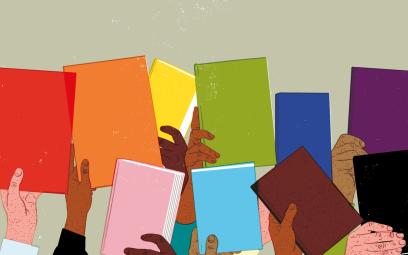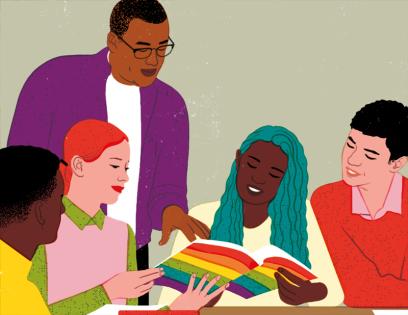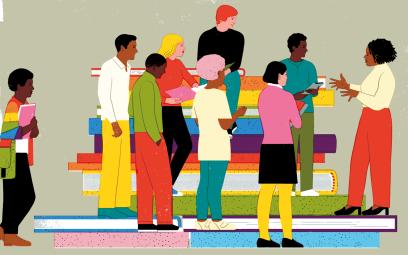Recent resistance to teaching students about the history of racial power and privilege dynamics in the United States has been accompanied by a parallel resistance to LGBTQ+ studies and resources in K–12 classrooms, libraries, and extracurricular spaces. Parents and politicians in two particular states have launched recent, highly politicized efforts to block exposure to LGBTQ+ culture through K–12 library book holdings and classroom reading curricula. Texas and Virginia have been the sites of heated arguments over the benefits and the dangers of students reading books with significant LGBTQ+ themes. Demands have been made of school boards in both states to forbid school libraries from circulating LGBTQ+ themed books. In 2021, a Texas state legislator, Matt Krause of Fort Worth, compiled a list of 850 books that he deemed in need of investigation because of sexuality- or racism-themed content that he found concerning for K–12 consumption.1 Framing the reading of LGBTQ+ themed books in K–12 as an issue of morality, Governor Greg Abbott2 insisted that the state’s education agency “investigate any criminal activity in our public schools involving the availability of pornography,” which has librarians worried that their book choices could be criminalized.
In Virginia, Governor Glenn Youngkin framed book bans as an issue of parental prerogative and control.3 The Henrico County Public Schools is one of the Virginia districts that has established a review committee to investigate parent concerns about the content of books. A parent filed a complaint with the school district about the appropriateness of a book titled I’m a Gay Wizard, found only in a district high school library, citing concerns that a scene of oral sex between two boy characters could result in “premature sexualization” and subsequent “pornography addiction.”4 Other states, such as South Carolina5 and Mississippi,6 have been the sites of similar conflicts.
In other states, legislatures have taken even more aggressive action to curtail the inclusion of LGBTQ+ culture in school curricula. Bills in states such as Tennessee, Missouri, Louisiana, and Florida have called for restrictions on the mention of any nonheterosexual orientation in classroom or extracurricular activities.7 The first such “Don’t Say Gay” bill was introduced during Tennessee’s 2005 legislative session. To date, such legislation has only been passed and signed into law in Florida. The Florida law restricts any Florida school district from encouraging “classroom discussion about sexual orientation or gender identity in primary grade levels [particularly K–3] or in a manner that is not age-appropriate or developmentally appropriate for students.”8 Critics of “Don’t Say Gay” bills argue that they violate the First Amendment rights of both educators and students and promote stigmatization of LGBTQ+ identity, which negatively affects the mental health of students who identify as LGBTQ+.
The Impact of LGBTQ+ Studies on Student Development
One of the arguments made against the rampant banning of LGBTQ+ themed books is that these books are instruments of self-discovery and identity development for some students who do not find this support elsewhere.9 In books with primary characters who identify as LGBTQ+, students are able to encounter images of themselves and narratives that mirror their own or their families’. They find models for families with same-sex parents, for coping with homophobia and transphobia, for coming out, and for forming support systems beyond their biological family. Integration of LGBTQ+ themed literature into school curricula also provides a space for challenging the homophobic and transphobic messaging that is still common in the United States. LGBTQ+ affirming course content can be a vital resource for healthy cultural identity development.
Several models exist to describe cultural identity development, with particular models articulated to outline various aspects of LGBTQ+ identity development. Professor Eli Coleman10 posits a five-stage model for gay and lesbian adolescent identity development. It consists of the pre–coming out stage, the coming out stage, the exploration stage, the first relations stage, and the integration stage. In the pre–coming out stage, individuals may question their sexual identity due to nonnormative sexual thoughts and attractions and try to resolve the internal conflict by seeking out information to increase their self-understanding. Books that normalize sexual identity confusion can help young people realize that they are not alone in their struggle for identity clarity and confirmation. Parents who oppose the inclusion of LGBTQ+ themed books in school libraries and school curriculum argue that LGBTQ+ themed books are most dangerous when youth are in this pre–coming out stage and may not be certain about sexual orientation identity.11 They argue that exposing students to information about LGBTQ+ identity without guidance may lead to premature acceptance of gay or lesbian identity. Books may also be a source of support during the other stages of identity development, during which time individuals begin to disclose their identity to others and to build their first relationships, friendships, and possibly romantic relationships as people who identify as gay or lesbian. Because these types of relationships are not commonly seen in mainstream culture, individuals may seek answers to questions about how to form and maintain such relationships from literature. The lack of candid conversations in families, churches, schools, and other civic settings about nonheterosexual identity development leaves a vacuum of the information, role modeling, and support that is critical for healthy self-esteem. Less research has been conducted to deepen understanding of transgender identity development than has been done for gay and lesbian identity development.12 Transgender identity development models often over-rely on models more relevant to sexual orientation identity development. A characteristic shared by all these differing models is that individuals typically experience anxiety about their identity not matching the heteronormative, cisgender mainstream and about how their interpersonal relationships may be affected.
Exposure to LGBTQ+ themed literature by students who do not identify as LGBTQ+ serves to challenge stereotypes and myths that may be held about nonheterosexual identities. Students who have been presented with negative, one-sided messages about LGBTQ+ people from home, places of worship, or various media outlets can explore other aspects of the needs, interests, and concerns of people who identify as LGBTQ+, providing these readers a space to reflect on biases and assumptions they have formed. Prejudices can typically be overcome when the person holding them has meaningful contact with the group that is the target of prejudice.13 This could happen through in-person interactions but may also be facilitated through literary contacts with persons from a group about whom prejudiced views are held.
The Role of Teachers in LGBTQ+ Studies Curriculum Construction
There is a very practical benefit to trusting teachers to craft lessons that integrate LGBTQ+ culture into their classrooms. Classrooms can be relatively safe spaces to challenge cultural biases and assumptions if discussions are managed appropriately.14 The availability of literature that depicts diverse cultures is important in helping young people develop cultural sensitivity and respect for those from different backgrounds. In the case of LGBTQ+ culture, gaining information about LGBTQ+ history and relationship dynamics is important in reducing misinformation that can fuel bullying, microaggressions, and other forms of discrimination in schools. Numerous studies document increased depression, anxiety, posttraumatic stress disorder, nonsuicidal self-injury, suicidal ideation, and suicidal activity linked to discriminatory treatment experienced by LGBTQ+ students in schools.15 To make effective this practical benefit of supporting teachers’ integration of LGBTQ+ culture into their classrooms, teachers must be allowed instructional autonomy to craft lessons around cultural competence. Instead, significant restrictions have been placed on educators in some areas.
Simply leaving to teachers decisions about integrating LGBTQ+ themes could have harmful results. Teachers who have unconscious biases toward LGBTQ+ people could unknowingly manifest these biases in the classroom. Oversight and accountability must exist in terms of cultural infusion in K–12 curricula. Advisory groups comprised of parents, teachers, school counselors, administrators, and community representatives, including people from culturally diverse backgrounds (race or ethnicity, sexual orientation, gender identity, religion, disability, etc.), are needed to support educators as they design lessons that address cultural communities with a history of marginalization, and school administrators have the ultimate responsibility to monitor the pedagogy of their teachers for content and teaching style.
Recent movements to limit LGBTQ+ themed literature is a matter of academic freedom for teachers, but it is also a matter of recognition of the LGBTQ+ community as a valuable cultural component of society rather than as an immoral faction of the population that should be avoided and silenced, especially by children and adolescents. Teachers who commit to designing lessons that include LGBTQ+ cultural content generally recognize the contributions of LGBTQ+ culture and the consequences for their students of living in a world that does not recognize these contributions. However, teacher-education programs should include intentional activities to equip future teachers to effectively integrate LGBTQ+ themed content into their classes. Professor Joseph Jones presents a model for faculty in teacher-education programs to help pre-service teachers learn to address homophobia in K–12 schools.† Laurie Hansen (a teacher-education fieldwork manager) proposes strategies for fostering safe discussions and critical thinking about LGBTQ+ topics.‡
The challenge for teacher-education programs is to prepare pre-service teachers to constructively confront resistance they may face in integrating LGBTQ+ themes into their classrooms. Professors Jill Hermann-Wilmarth and Caitlin Law Ryan16 suggest that it is prudent to expect that some parents will object to the inclusion of LGBTQ+ themes in elementary school classrooms but that teachers should avoid overgeneralizing that all parents will resist. Hermann-Wilmarth and Ryan suggest helping pre-service teachers gain comfort with some simple strategies for navigating the inclusion of LGBTQ+ themes in elementary school curricula, such as clearly situating LGBTQ+ themes within the larger realm of inclusion and diversity. The authors suggest incorporating LGBTQ+ themed literature as part of a series of books about understanding different types of families or traditions, alongside topics such as multiracial families or families with differently abled people. Hermann-Wilmarth and Ryan also recommend creating a space to educate parents about the importance of LGBTQ+ inclusion in the elementary classroom and to apprise parents of the scope and limits of the inclusion so that parents understand the age-appropriateness of the lessons. Lastly, rather than simply abandoning the lesson plan, teachers who encounter resistance should be prepared to offer individual accommodations for students whose parents adamantly object to their children participating in LGBTQ+ themed lessons. For pre-service teachers, these can be moments of great apprehension and anxiety. Teacher-education program faculty must commit themselves to equipping pre-service teachers to confront the variety of reactions they may face to incorporating LGBTQ+ themes into elementary classrooms. Faculty should also empower pre-service and novice teachers by helping them understand that teachers’ freedom to design and execute curricula does not preclude the need to engage with parents to secure buy-in.
Current political efforts to prohibit any incorporation of LGBTQ+ themes in elementary school pedagogy directly contradict the multicultural competencies required by the Council for the Accreditation of Educator Preparation and prioritized in most teacher-education academic programs. Do program leaders simply yield to legal pressures and stop teaching pre-service teachers to skillfully acknowledge alternatives to heteronormativity in elementary school classrooms, or do they equip pre-service teachers to be advocates for inclusion even in defiance of legal restrictions? Teacher-education programs do not teach pre-service teachers to promote any particular sexual orientation or gender identity but instead prepare them to appropriately recognize that differences in identity and family structure do exist, without endorsing one as preferred and others as inferior.
Conclusion
Rather than restricting K–12 teachers from introducing LGBTQ+ themed information into their classes, an alternative approach is to develop curricula that are transparent and provide basic learning objectives related to LGBTQ+ culture. These can help professionals, including teachers, study constructs like cultural competency,17 cultural humility,18 and cultural efficacy19 to use as frameworks for their own self-reflection and professional practice. Teachers trained in cultural competency, cultural humility, and cultural efficacy are prepared to reflect on their own biases and assumptions, identify power and privilege dynamics, and craft lessons that are culturally affirming. Such educators teach in a way that welcomes multiple perspectives. Also, having some background in developmental psychology, educators have insights about psychosexual development and about what is age-appropriate for students. Teacher-education programs need the latitude to freely craft their curricula of multicultural infusion based on what is known about children’s ability to appropriately grasp differing cultural identities from the social sciences rather than based on political pressures.
Ricardo Phipps is the dean of the School of Humanities and Social Sciences at Stevenson University. A licensed professional counselor, he is active with the Maryland Counseling Association and recently served as president of the Maryland Association for Multicultural Counseling and Development (2021–22).
†Jones explains his model in “Infusing Multicultural Education into the Curriculum: Preparing Pre-Service Teachers to Address Homophobia in K–12 Schools,” which is available for free at files.eric.ed.gov/fulltext/EJ1104934.pdf. (return to article)
‡Hansen shares her strategies in “Encouraging Pre-Service Teachers to Address Issues of Sexual Orientation in Their Classrooms: Walking the Walk & Talking the Talk,” which is available for free at files.eric.ed.gov/fulltext/EJ1065498.pdf. (return to article)
Endnotes
1. B. Chappell, “A Texas Lawmaker Is Targeting 850 Books That He Says Could Make Students Feel Uneasy,” National Public Radio, October 28, 2021.
2. Letter from Governor Greg Abbott to Commissioner Mike Morath, November 10, 2021, gov.texas.gov/uploads/files/press/O-MorathMike202111090719.pdf.
3. E. Harris and A. Alter, “Book Ban Efforts Spread Across the U.S.,” New York Times, February 8, 2022.
4. K. O’Brien, “Henrico Schools Pull Two Books for Review over Sexual Content Concerns,” WRIC News, January 25, 2022.
5. N. Prieb, “South Carolina Governor Urges Banning of LGBTQ Book in Schools,” The Hill, November 12, 2021.
6. A. Davis, “Mississippi Mayor Withholding Funds Until LGBTQ Books Removed, Library Director Claims,” Newsweek, January 27, 2022.
7. P. Barbeauld, “Don’t Say Gay Bills and the Movement to Keep Discussion of LGBT Issues Out of Schools,” Journal of Law and Education 43, no. 1 (2014): 137–46.
8. Fla. H.R. CS/HB 1557, Reg. Sess. 2021–2022 (2022), flsenate.gov/Session/Bill/2022/1557/BillText/c1/PDF.
9. L. Moorhead, “LGBTQ+ Visibility in the K–12 Curriculum,” Phi Delta Kappan 100, no. 2 (2018): 22–26.
10. E. Coleman, “Developmental Stages of the Coming Out Process,” Journal of Homosexuality 7, nos. 2–3 (1982): 31–43.
11. J. Hermann-Wilmarth and C. Ryan, “Navigating Parental Resistance: Learning from Responses of LGBTQ-Inclusive Elementary School Teachers,” Theory into Practice 58, no. 1 (2019): 89–98.
12. S. Katz-Wise et al., “Imagining the Future: Perspectives Among Youth and Caregivers in the Trans Youth Family Study,” Journal of Counseling Psychology 64, no. 1 (2017): 26–40.
13. R. Crisp and R. Turner, “Can Imagined Interactions Produce Positive Perceptions? Reducing Prejudice Through Simulated Social Contact,” American Psychologist 64, no. 4 (2009): 231–40.
14. M. Schieble, “A Critical Discourse Analysis of Teachers’ Views on LGBT Literature,” Discourse: Studies in the Cultural Politics of Education 33, no. 2 (2012): 207–22.
15. Centers for Disease Control and Prevention, “LGBT Youth,” June 21, 2017, cdc.gov/lgbthealth/youth.htm.
16. Hermann-Wilmarth and Ryan, “Navigating Parental Resistance.”
17. D. Sue, P. Arredondo, and R. McDavis, “Multicultural Counseling Competencies and Standards: A Call to the Profession,” Journal of Multicultural Counseling and Development 20, no. 2 (1992): 64–88.
18. M. Tervalon and J. Murray-Garcia, “Cultural Humility Versus Cultural Competency: A Critical Distinction in Defining Physician Training Outcomes in Multicultural Education,” Journal of Healthcare for the Poor and Underserved 9, no. 2 (1998): 117–25.
19. A. Nunez, “Transforming Cultural Competency into Cross-Cultural Efficacy in Women’s Health Education,” Academic Medicine 75, no. 11 (2000): 1071–80.
[Illustrations by Sonia Pulido]



